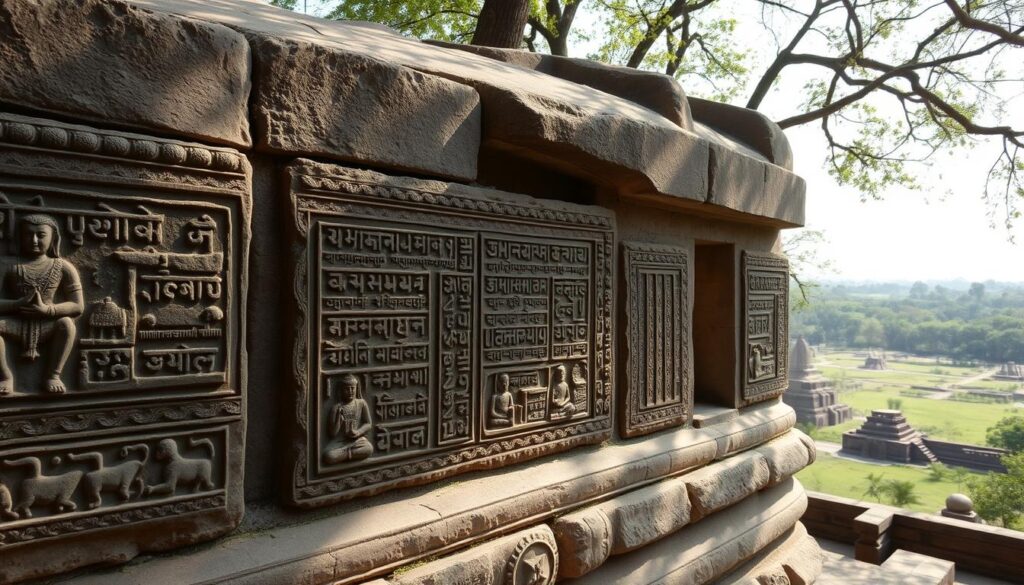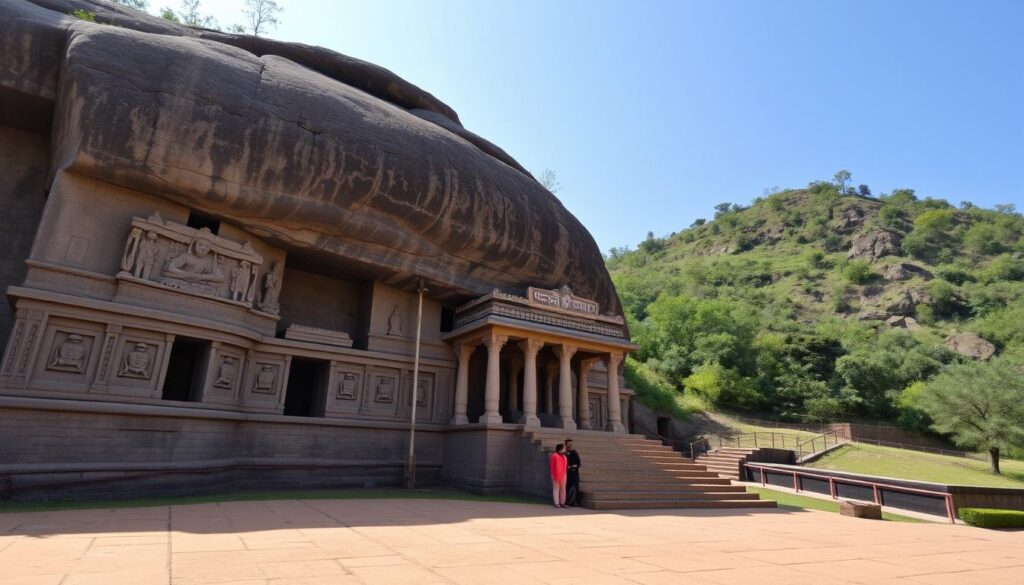Explore Dhauli Temple: A Buddhist Marvel in Odisha
The Dhauli Temple is in Bhubaneswar, Odisha’s capital. It’s a stunning Buddhist site that has drawn visitors for ages. This ancient wonder shows off the area’s deep cultural roots and Ashoka’s life-changing journey.
The Dhauli Temple’s story is linked to the Kalinga War, a key moment in India’s past. It happened by the Daya River, where Ashoka’s desire for war ended. This event sparked his spiritual growth and spread of Buddhism across his empire.

Key Takeaways
- Dhauli Temple is an ancient Buddhist site located near Bhubaneswar, Odisha, India.
- It is associated with the Mauryan emperor Ashoka and his Kalinga War, which led to his spiritual transformation.
- The temple features remarkable rock-cut carvings and the Shanti Stupa, a symbol of peace.
- Dhauli Temple is an important pilgrimage site for Buddhists, showcasing the region’s rich cultural heritage.
- The Daya River and the scenic Dhauli Hills provide a serene and picturesque backdrop to the temple.
Unveiling the Mysteries of Dhauli Temple
The Dhauli Temple in Odisha is a key part of the region’s Buddhist history. It lets visitors see amazing rock carvings and buildings that have lasted for ages.
At Dhauli Temple, you must see the elephant sculptures. They are carved into the rocks. These elephants remind us of the Ashoka inscriptions and the Mauryan Empire’s role in Buddhist monuments.
The Shanti Stupa is another highlight. It’s a symbol of peace and adds to the temple’s charm. This architectural wonder shows the site’s Buddhist stupa heritage and invites visitors to think about its spiritual meaning.
“The Dhauli Temple is a true testament to the enduring legacy of Buddhist art and architecture in Odisha.”
Walking around, you’ll see the rock edicts well kept. They tell us about Ashoka’s change from a conqueror to a follower of peace. These inscriptions give us a peek into the site’s history and Ashoka’s spiritual journey.
Dive into the history of Dhauli Temple and discover its secrets. From the famous rock carvings to the peaceful stupa, every part of this site invites you to explore the ancient past and Buddhism’s lasting impact.
The Historical Significance of Dhauli
Dhauli Temple is linked to the legendary Mauryan emperor, Ashoka. It marks a key moment in Ashoka’s life after the Kalinga War. This war changed him, leading him to Buddhism.
Ashoka’s Kalinga War and Spiritual Awakening
The Kalinga War was a turning point for Ashoka in the 3rd century BCE. The war’s destruction deeply affected him. He then turned away from violence and followed the Buddha’s teachings.
The rock edicts at Dhauli show Ashoka’s spiritual change. They highlight his commitment to peace and non-violence.
The Mauryan Empire’s Influence on Buddhism
Under Ashoka, the Mauryan Empire helped spread Buddhism. The Ashokan inscriptions at Dhauli give insights into his efforts. He built stupas, monasteries, and spread the Buddha’s teachings.

“Ashoka’s transformation from a warrior-king to a devoted patron of Buddhism is a defining moment in the history of the Mauryan Empire and the spread of the Buddhist faith.”
Dhauli Temple takes visitors back to a crucial time in India’s history. It shows the Mauryan Empire’s influence on Buddhism and Ashoka’s spiritual journey.
The Architectural Splendor of Dhauli Temple
Dhauli Temple shows off the area’s rich Buddhist architecture and culture. As you wander through, the rock-cut elephants on the temple will amaze you.
Exploring the Rock-Cut Elephants
The rock-cut elephant sculptures at Dhauli Temple are truly eye-catching. They stand at the entrance, telling the story of Ashoka’s change after the Kalinga war. The detailed work on these archaeological wonders shows the skill of local artists.
The Shanti Stupa: A Symbol of Peace
On the Dhauli Hills, the Shanti Stupa, or Peace Pagoda, offers a stunning view. Its white dome and carvings symbolize peace and spiritual growth in the area.
“The Dhauli Temple’s architectural splendor is a true testament to the region’s rich cultural heritage and the enduring influence of Buddhism.”
Dhauli Temple: A Pilgrimage Site for Buddhists
Dhauli Temple is a sacred place for Buddhist followers. It’s a famous buddhist pilgrimage site, drawing visitors from everywhere. They come to honor the Buddha’s teachings and Ashoka’s role in spreading buddhism in ancient India.
The temple sits beautifully in the Dhauli Hills. It offers a calm spot for deep thought and reflection. You can see the detailed buddhist monuments and sculptures. Each one tells a unique story of odisha heritage sites.
“Dhauli Temple is a sacred place where the dhamma, the teachings of the Buddha, are deeply felt and honored by devotees from around the world.”
Visiting Dhauli Temple is a deep and enlightening experience. It’s perfect for both buddhist pilgrims and curious travelers. The temple’s enduring spirit and strong Buddhist ties make it a key spot for exploring Odisha’s spiritual and cultural heritage.

On your way to Dhauli Temple, get ready to be amazed. The mix of history, spirituality, and nature makes it a standout odisha heritage site.
Exploring the Ashoka Rock Edicts
At the Dhauli Temple, visitors find the Ashoka rock edicts a major draw. These inscriptions, carved into the rock, give a peek into the past. They show the teachings and policies of the Mauryan Empire and its Buddhist beliefs.
Deciphering the Edicts’ Inscriptions
The Ashoka rock edicts at Dhauli are some of the oldest and best-preserved in India. These ashokan inscriptions open a window into the ancient world. They let visitors explore the rich buddhist heritage and archaeological site of this sacred place.
The inscriptions, written in the Brahmi script, shed light on the Mauryan Empire’s policies and beliefs. They reveal how Ashoka, after the Kalinga War, changed his ways and followed Buddhism.
“These inscriptions offer a unique glimpse into the past, revealing the Mauryan Empire’s influence on the spread of Buddhism throughout ancient India.”
Understanding the ashokan inscriptions lets visitors dive into the cultural and historical importance of the Dhauli Temple. It turns the temple into a living archaeological site. It shows the lasting legacy of the Mauryan era and Ashoka’s spiritual journey.
The Daya River: A Serene Backdrop
The Daya River flows gently through the Dhauli Hills, creating a peaceful scene. This river, with its clear waters and green surroundings, makes the Dhauli Temple even more special. It invites visitors to enjoy the natural beauty of the area.
The river’s soft sounds and the Dhauli Hills make the temple a place of calm. It’s perfect for those seeking spiritual peace and nature lovers. The temple and the river show how well nature and spirituality can work together.
Walking by the Daya River, you’ll feel the calm and see the stunning views. The Dhauli Temple’s beauty, along with the river, leaves a lasting memory. It’s a special place in Odisha that invites you to pause and reflect.

“The Daya River flows gently alongside the Dhauli Hills, creating a serene and peaceful backdrop that enhances the spiritual essence of the Dhauli Temple.”
Dhauli Hills: A Natural Wonder
The Dhauli Hills sit by the calm Daya River, blending natural beauty with the Dhauli Temple’s rich history. These hills, covered in greenery and with paths that wind, call out to those who love the outdoors. They invite you to explore and enjoy the scenery.
Trekking Through the Scenic Landscapes
Outdoor fans will find plenty to do in the Dhauli Hills. Walking through the hills, you’ll see beautiful views of the countryside. You might also see different plants and animals, adding to the magic of your trip.
For a bigger challenge, the Dhauli Hills have many trails for all levels. Whether you’re an experienced hiker or just love nature, there’s something here for everyone. It’s a mix of history and nature that’s hard to find elsewhere.
“The Dhauli Hills offer a perfect canvas for nature lovers to explore the wonders of Odisha’s great outdoors.”
Walking through the Dhauli Hills, you’ll feel a deep calm. The temple’s history and the natural beauty together make for a special experience. It’s a place you must see if you love the outdoors in Odisha.
Bhubaneswar Tourism: Dhauli Temple as a Must-Visit Attraction
Exploring Bhubaneswar, the capital of Odisha, reveals a treasure: the Dhauli Temple. This Buddhist landmark is a key spot for those wanting to dive into the area’s history and architecture.
Bhubaneswar is known for its heritage sites and archaeological wonders. Dhauli Temple, in the Dhauli Hills, shows the city’s rich culture. It highlights Buddhism’s lasting impact and the Mauryan Empire’s history.
The temple’s rock-cut sculptures, like the rock-cut elephants, showcase ancient artistry. The Shanti Stupa adds to its charm, drawing both spiritual and architectural fans.
“Dhauli Temple is a true masterpiece, blending Buddhist philosophy, Mauryan influence, and breathtaking natural beauty. It’s a must-visit attraction for anyone exploring the wonders of Bhubaneswar tourism.”
Visiting Dhauli Temple, you’ll enjoy its calm atmosphere. The Daya River and Dhauli Hills offer scenic views and trekking paths. These enhance the temple’s spiritual and historical value.
Dhauli Temple is perfect for history buffs, nature lovers, or anyone looking for a cultural journey. It promises a memorable experience, showcasing Odisha’s heritage.

The Dhauli Temple: A UNESCO World Heritage Site
The Dhauli Temple is known for its deep historical and cultural importance. It has been recognized as a UNESCO World Heritage Site. This honor highlights its value as a symbol of the Mauryan Empire’s legacy and the rich Buddhist heritage of the region.
This temple is located in the peaceful state of Odisha. It shows the strong link between the area and Buddhism. Visitors can see detailed rock-cut sculptures and the famous Shanti Stupa. These are reminders of Emperor Ashoka’s spiritual change after the Kalinga War.
Visiting the Dhauli Temple is a chance to learn about Buddhism’s early days in India. The site’s Ashoka Rock Edicts share teachings on compassion and non-violence. This makes the Dhauli Temple a key place for learning and inspiration for many.
FAQ
What is the significance of the Dhauli Temple?
The Dhauli Temple is an ancient Buddhist site near Bhubaneswar, Odisha, India. It’s famous for its link to Mauryan emperor Ashoka. The site’s rock-cut carvings show the area’s rich culture.
What can visitors see at the Dhauli Temple?
Visitors can see ancient rock-cut carvings, including elephant sculptures. They can also visit the Shanti Stupa, a symbol of peace. The site’s architecture and archaeological wonders give a glimpse into the past.
What is the historical significance of the Dhauli Temple?
The Dhauli Temple is linked to Mauryan emperor Ashoka. After the Kalinga War, Ashoka changed his ways, embracing Buddhism. The site’s rock edicts and inscriptions show Ashoka’s commitment to peace and Buddhism.
What are the architectural highlights of the Dhauli Temple?
The temple’s architecture is stunning. Visitors can see the awe-inspiring elephant sculptures. The Shanti Stupa on the Dhauli Hills offers a panoramic view.
Why is the Dhauli Temple a pilgrimage site for Buddhists?
Dhauli Temple is sacred for Buddhists. It attracts visitors worldwide. They come to honor the Buddha and Ashoka, who spread Buddhism in ancient India.
What can visitors discover at the Ashoka Rock Edicts?
The Ashoka Rock Edicts are a major attraction. They are early and well-preserved examples in India. These inscriptions reveal the Mauryan Empire’s teachings and policies.
What is the significance of the Daya River at the Dhauli Temple?
The Daya River adds to the temple’s beauty. Its calm waters and green surroundings create a peaceful atmosphere. This enhances the site’s spiritual feel.
What can visitors experience at the Dhauli Hills?
The Dhauli Hills are a natural wonder. Visitors can enjoy scenic treks and stunning views. The hills offer a mix of culture and nature, appealing to all.
Why is the Dhauli Temple a must-visit attraction in Bhubaneswar?
Dhauli Temple is a key part of Bhubaneswar’s attractions. As Odisha’s capital, Bhubaneswar is known for its culture and history. Dhauli Temple is a highlight for those interested in ancient Buddhism and architecture.
What is the Dhauli Temple’s UNESCO World Heritage status?
The Dhauli Temple is a UNESCO World Heritage Site. This recognition highlights its cultural and historical value. It ensures the site’s preservation and promotes it as a top cultural destination in India.




0 Post a Comment: